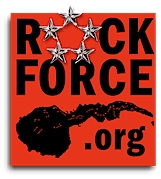21 February 1945
- Day 6
The Rock Force had now
completed five days on the Fortress. The action had been violent. The
Japanese had a large force ready to defend the island to the death when
the expected amphibious assault came. To their complete surprise the
enemy attacked from the sky. This could be likened to a bunch of cats
being thrown into a pit full of dogs. There was no escape for either.
The fight was to the death with the superior emerging as the conqueror.
By this time the powers
that be knew that the U.S. forces were well on the way to victory. It
was now a matter of rooting out the separated, uncoordinated forces.
This was little comfort to the men doing the "rooting out." They had
been through five days of constant danger, seeing their friends fall
around them, and as far as they could see the end was not in sight.
Most had slept little, had suffered from extreme thirst, eaten K
rations, endured the indescribable stench of the dead bodies lying all
around, suffered the discomfort of wearing filthy fatigues which were
so salt encrusted that they were stiff, endured the fine dust covering
everything on the island and, worst of all, had been covered with flies
- millions of flies breeding on the bloated, stinking bodies of the
enemy.
Now
begins Day 6. Some who ate their breakfast of a box of K rations were
eating their last meal. Was there a prevailing sense of despair? No,
there are always pessimists, but most of these still had hope, despite
their efforts to hide it. What is a human without hope? Doctor
Bradford put it so well in his "Combat Over Corregidor" in
describing his first moments of consciousness after awakening one
morning before the sun rose:
"For
a moment my eyes reached up into the soft, spotless blue, and I
thought to myself, 'God's in his heaven -- all's right with the
world.� I remember now how we often used to recite that verse
at the opening of my classes at school - bright eyes, shining faces,
laughter, and the unclouded thoughts of childhood had awakened me
here, like Rip Van Winkle, twenty years later, on Corregidor."
RCT

|
|
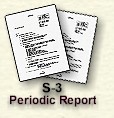
No. 6
201800I February 45
to
211800I February 45 |
3. OUR
OPERATIONS:
a. Infantry During
the period our troops continued the assault of enemy emplace�ments along the
entire coast of the western end of the rock. Five caves containing a total
of nineteen Queen boats were located and sealed in the vicinity of
33.1-40.3. The coastline from MORRISON POINT to CAPE CORREGIDOR at
30.4-40.0 was cleared and few if any enemy remained in the area." Not
quite so!
"WHEELER
POINT to SEARCHLIGHT POINT was assaulted by a combined naval and ground
strike, clearing it of all but a few possible stragglers."
More fabrications.
"The area in which the enemy may
remain in any strength on the western end are the coastal stretches between
BREAKWATER POINT and GEARY POINT, and BATTERY POINT to MORRISON POINT."
Remember this nonsense
when we get to the events of 22, 23, and 24 February. Regiment, at least
the S-3, never seemed aware that action occurred on the western end of the
island. Either this was true or they knew and chose to ignore three sharp
actions by the rifle companies of the 2nd Battalion. Now back to the 503's
great obsession, the closing of caves and tunnels. "Forty-eight
(48) tunnels and caves were sealed during the period for a total of one
hundred and thirty-two (132) to date."
Question? How many of these
stayed closed?
4. CASUALTIES:
a. Our casualties: This
report- 4 KIA, 14 ~A, 4 JUMP TIA (Additional reported; 13 MIA.
To date- 89 KIA, 248 WIA, 197 JUMP IIA, 13 MIA.
b. Enemy casualties:
This report- 352 KIA, 0 PW To date- 2190 KIA, 3 PW |
|
|
|
|
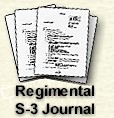
#96 0800 |
Enemy dug out of - blocked
caves and rolled grenades down on "C" Co positions killing 1 and
wounding 4. |
|
#97 0800 |
Nite
very quiet and only noise is the usual fire of artillery covering draws.
Flares sent up over enemy positions during nite to prevent surprise
attacks by the enemy. |
|
#98 0900-2400 |
2nd Bn
moved down James Ravine and had observed fire from Navy on area between
Morrison Point and Rock point. Dog Co patrolled area south of Rock
Point and reported 60 Japs KIA at (30.2-40.5) due to air corp & 81mm
mortar fire. Made contact with "E" Co 11501 with "D" Co. "E" Co
patrolled area toward Morrison Point and then west to Rock Point. Fox
Co patrol area NW to Rock Point. No enemy seen. Arty laid down barrage
between 0800 & 0855 killing 60 enemy in vicinity of (30.00-40.45)."
|
|
Read the company
histories below carefully. I have already commented on the S-3 above. |
|
#99 0900 |
1st
Bn kept on cleaning out caves between Searchlight point and Breakwater
-Pt. Hill attacked with caves and-many dead Japs inside from naval
barrage. Caves sealed as they are checked out and some that cannot be
flushed out are sealed burying the enemy alive. |
|
#100 0900 |
3rd Bn - "I" Co continued to
clean up caves from Breakwater point to beach area. Light fire received
but no enemy action in force. "H" Co continued cleaning area around
Battery point. Destroyed caves and 19 suicide boats hidden in caves at
water level. They found possible landing beach west of Battery point and
well mined as if expecting a beach landing. Parachute landing surprised
them according to the few prisoners captured "G" Co moved C.P. and
strengthened perimeter. |
|
#101 1030 |
Air
strike both bombing and strafing on Malinta Hill N.E. section.
Repeated raids carried out during day. |
|
#102 2130 |
Terrific
explosion racked whole island and came from vicinity of Malinta tunnel.
Banzai by 12 Japs from main entrance just after explosion and quickly
exterminated by mg fire from 34th Inf. Reports that flames came from
entrances of Malinta tunnels and opening some of the entrances
previously closed by bombing. Landslides caught some of the 34th Inf
men located on side of hill. Evacuation difficult. Previous to
explosion the tunnels which had been a mystery and stumbling block had
been doomed to be sealed entirely. This sort of eased the situation.
Plans made for cleaning up of Topside and 23 Feb to clean up eastern end
of island E of Malinta tunnels. |
|
#103 1030 |
Report to XI Corp msg
#1 of bombing (and) strafing of eastern Corregidor to be followed by
naval strike. |
|
#104 1710 |
Msg #2
reporting to XI Corp bombing and attempted sealing of Malinta Tunnels. |
|
#105 2030 |
Situation report for
period to XI Corp by msg #3. |
|
#106 2133 |
Report
heavy explosion in south part of Malinta tunnels to XI Corps by msg.#5. |
|
#107 2225 |
Report further on
Malinta tunnels to XI Corp. |
|
#108 2400 |
Nite
quiet as no art fire on draws tonite. Enemy forces pretty pretty well
wiped out on "Topside" and no organized attacks imminent. Heavy arty
kept in place thou ( as security measure. Plans being made for complete
mopping up of the eastern end of the island with the 1st Bn, 503 RCT and
3rd Bn, 34th Inf. Situation well under control." |
|
It is evident that
the S-3 felt that the western end had been completed and only the
eastern end contained a few Japs who must be "mopped up" |
|
|
|
|
|
|
 |
This is
the first morning that I have to think of something to write. Yesterday
was the quietest day for our infantry troops. All day there was
harassing fire by the mortars, howitzers and some Navy shelling at the
tunnels on the coast. In the afternoon E Co. went down and closed up
about 15 tunnels that had been blasted. Otherwise the day passed
uneventfully. Toward evening we started taking up the same perimeter-
it had worked out swell the night before and it worked out again last
night. There was more harassing fire than before. Howitzer and mortar
shells were thrown out all night long. There was almost no small arms
fire heard at our C.P. This morning started with the mortars throwing
out lots of ammo while E Co. moved in to take the next ridge at the N.W.
corner of the island. I think the general plan today is for our
battalion to work down and clear the west end, E Co. on the north, F Co.
down the center and D Co. on the south. With the help of artillery and
naval fire they expect to meet and thus we'll occupy this whole end of
the island. But we can't possibly man it by night-so if there are still
Nips around they can move in again at night, so we've got the same job.
From what we hear, the Malinta Tunnel is chock full of little yellow
men, food and enough ammo to blow up the island. That seems to be the
problem - whether to let them blow it up or for us to blow it up or
what? Anyway, things are more quiet. They've been evacuating wounded
and dead all morning. The latest Nip count is 1823. Our company's
casualties to date are 31 hospitalized and 3 killed." |
|
The account of the
2nd Battalion's mission is true, i.e., to clear the island coast from
Morrison Point on the north around the west to Searchlight point on the
south. Obviously the journalist knows more about the goings on of E
Company. This in natural, because E company was so near them at the
topside barracks. Early a great amount of the mortar fire;, along
with artillery fire, is being fired into Cheney Ravine to lay the way
for D Company's attack down Cheney trail to the coast, as stated below. |
|
|
|
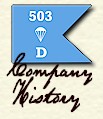 |
The Co. went out to clean
Japs out of ravine below the big gun position and to clean out the caves
along the water's edge. A field artillery and mortar preparation was
fired before the company moved out and at 0830 the company moved into
the ravine. About a third of the way down the ravine four Japs were
found hiding under a culvert and killed. Two more were found in a
pillbox further down the trail and killed. A Jap water point was found
which was much better than former points. As the patrol continued down
the trail barbed wire entanglements and land mines were encountered.
Six Jap anti-aircraft guns were found. About twenty well armed Japs
were encountered in a cave along the water's edge. One squad approached
the cave from one side while another circled it and came in from the
other side. During this attack, Pvt. Brady was killed and Lt. Buchanan
and Bowers, attached medic, were wounded. About twenty six japs were
killed and two tunnels blown up. Co tied in with "E" Co. and set up a
perimeter along the shore. No night action." |
|
|
|
Doc Bradford accompanied
D company on this foray and describes it in his manuscript, "Combat Over
Corregidor."
In reading the company
diaries that were written at the time, February 1945, it is noticeable
that few names are known. For example, the D company History entry
above speaks of the "ravine below the big gun position." In our
accounts written later, supplied with the 1 inch equals 200 feet map of
Corregidor and plans and specifications of of the fortress's secrets, we
'could supply the proper names. The "ravine" is Cheney Ravine and "the
big gun position" is Battery Cheney.
Attempts to close
concrete-lined tunnels and entrances did not "seal" them. The concrete
was 12 inches thick and reinforced by one inch steel rods. To seal them
would have required explosives by the truck load. The TNT charge
loosened large amounts of earth which piled down in front of the
entrance forming a protective wall 4-6 feet in height. Entry could be
gained by climbing over the wall. Fortunately, few tunnels were
reoccupied, because there were no live Japs left in the area. |
|
|
|
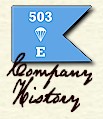 |
"0800
The company with LMG and Engr platoon attached, started on patrol
along James Ravine to the beach and along the water to Cape Corregidor.
Engr's. closed 2 caves and company killed 16 Nips. PFC. Culpepper WIA
by grenade fragments. Before we moved along the beach a destroyer laid
fire along the high ground overlooking the beach. On the way back from
Cape Corregidor along the road net, we found many vehicles dispersed by
the Japs. There were vehicles of all descriptions: trucks, sedans,
motorcycles, the Jap version of the Jeep, etc. and all were very well
camouflaged. Most were in good condition." |
|
|
|
|
These vehicles were parked under the
remaining trees along Grubbs Trail. The Japanese had concealed them
here in the vicinity of the "big cave" and the surrounding bomb proofs
so that they could be used in a swift movement of the troops in mounting
a counter attack against a seaborne invasion elsewhere on the island.
Unlike the issue of whether or not there
was naval support prior to E Company's patrol towards Wheeler Point on
the 23 February, in this instance Don Abbott confirmed that a destroyer
did shell the bluffs |
|
|
|
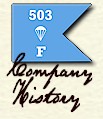 |
No entry for 21 February |
|
|
|
|

|
We moved back to the Battery Hearn area. The 1st
platoon was given the mission of patrolling down Sunset Ridge to the sea
in the Cape Corregidor area. We were to clear the ridge and the south
slope which is Cheney Ravine. We were sure there were Jap positions in
Grubbs Ravine, so we were to avoid this area until a larger force, such
as the entire company, would be used to make an attack. At the same time
D Company moving to the northwest and B Company mov�ing to the southwest
would stay on the beaches. Moving along the upper part of the south
slope and the ridge we moved toward the sea until the ridge dropped off
too sharply to travel any further. We were on the edge of the bluffs
overlooking the sea. We heard American voices below us but could not see
them. They were on the North Shore Road which was cut into the bluffs
some 20-30 feet above the narrow beach. After establishing voice contact
we found that we were above B Company. There was no trail or route we
could use to get down directly to the road, so we backed up along the
ridge for a distance and worked our way down to the road in Cheney
ravine and followed the road around to Company E. We were near the
Battery Hannah area. We knew the Japs were around the bend in Grubbs
Ravine, because the fire directed at the 2d platoon which had killed
Patterson came from this area. E Company had missed this area, because
they had followed the shore line, thus passing about 150 yards west of
RC/6.
Sometime later, E Company took Grubbs Trail off
North Shore Road, passed above the two entrances to the big cave and
within 75 yards of RC/6. Evidently the Japs could not see them, because
they passed unmolested. They found the long line of vehicles parked on
Grubbs Trail, as stated in E Company history.
After completing our mission to patrol to the sea,
and incidentally contacting E Company, we retraced our steps via Cheney
Ravine to Sunset Ridge. In searching this area we followed Grubbs Trail
westward and discovered the vehicles mentioned in E Company's history.
There were many old Chevrolet Army trucks - flat beds and rear wheel
drive; many civilian automobiles including quite a few convertibles; and
odds and ends. I believe the Japs had collected the vehicles there in
order to be able to move their reserve force rapidly to any place where
they were needed. When the vehicles were parked they were concealed
from observation by heavy forest and dense foliage, but the intense
bombings during January and the earlier part of February thinned out
the cover until the airmen were able to see the vehicles lined up
bumper to bumper. It was readily evi�dent from the large number of .50
calibre holes in the vehicles that they had been repeatedly strafed.
They reminded me of the death car of Clyde Barrow and Bonnie Parker
which I had seen on display at the Louisiana State Fair in Shrevesport.
Several days later when things were quieter, we started the lead
vehicle, a Chevy truck. What water was left came squirting out the .50
calibre holes in the radiator.
On this day, however, knowing that we were in the
proximity of the area where the Jap fire had come from the day before,
we were very cautious and quiet. As we quietly moved along the line of
vehicles, we came to a truck with a Jap lying asleep in the bed. We
jerked him out, set him on his feet, and started back up the trail
toward Battery Smith. The prisoner went along quietly for a short
distance, but then went berserk, shouting and spitting at us, then
fighting and kicking. This was no place for a ruckus, for we did not own
the ravine � so he was shot.
Thereafter, our movement to Battery Smith was
very rapid and uneventful. I do not know who came up the trail first, E
Company or us. I feel like they did, because we stayed in the Battery
Smith area for some time and should have seen them if they were behind
us. I only learned a few years ago, from Don Abbott, that E company had
used Grubbs Trail that day. I had heard that "E" Company discovered a
line of vehicles, though for many years had thought this was in James
Ravine. |
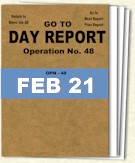 |
"D" Company and "E" Company did not spend the night on
the coast as stated in "D" Company's history. When "E" Company came up
Grubbs Trail they were on their way to Topside. They occupied their
usual perimeter near Topside Barracks. "D" Company occupied their usual
perimeter at the NCO Quarters. "F" Company went back to their position at
Post Headquarters-Light House.
So ended
our sixth day on Corregidor. Had the Japs been able to mount an
organized attack, now would have been the time. The hard work,
burning heat, flies, and dust had taken their toll. Our sleep was now
the hypnosis of sheer exhaustion. |
|
|
|
|
|
 |
|
|
 |
|
21 FEBRUARY 1945 - DAY 6
|

